Content
In the wake of the general enthusiasm for chickens and quails, other birds, bred by man in private farmsteads, remain behind the scenes. Little else people remember about turkeys. In general, this state of affairs is justified. Chicken and turkey can be seen on store shelves, and quail is trendy.
But besides these three types, there is still guinea fowl, pheasants and peacocks, as well as waterfowl - ducks and geese.
There are more than 110 species of ducks in total, and 30 of them live in Russia. The domestic duck comes from the mallard duck.
Mallard ducks were kept in ancient Greece, but so far they have not been fully domesticated. Evidence that the domestication of the duck has not been completed is that the duck runs wild easily.
Unlike chickens, a fleeing duck does not seek to return home, although they can be kept nearby by providing food. When the food runs out, the duck will go on a journey in search of a new feeder.
Domestic duck, obese from a quiet life and readily available food, does not come across as a good flyer, but it is not. Contrary to the belief that a duck needs a run on the water to take off, it is quite capable of soaring into the sky with a candle straight from the spot. It's just that the duck is often too lazy to do it. The behavior of domestic ducks is very similar to the behavior of urban pigeons: "I can fly, but I don't want to, and I'm not afraid of people either."
The wild mallard gave rise to almost all breeds of domestic ducks. But the differences between breeds are small, especially compared to chickens.
It is better for a beginner to start breeding ducks from "noblewomen", another name is "Peking duck", as close as possible to the wild type, or from Indo-ducks, they are musk ducks.
Domestic mallards (Peking ducks)
In the photo there are wild mallards. But pets are often completely indistinguishable in color. So if a domestic mallard joins a herd of wild ducks, it will be impossible to find it there. Unless the escaped duck will be piebald or white.
Domestic mongrels, although these ducks are often called Peking ducks, ducks can be piebald or white, since humans retain a color that is very undesirable in nature.
The maximum weight of a wild mallard is 2 kg. The "noblewoman" has the same weight and dimensions.
The advantage of outbred mallards is that they have a superbly developed incubation instinct. From 6 ducks and 2 drakes without human intervention per season, you can get 150 heads of young animals weighing 1 - 1.5 kg in 2 months.
But the incubation of duck eggs is a troublesome business not only for beginners. And not even every incubator is suitable for this business. We'll have to buy an automatic one with the ability to regulate temperature and humidity.
Muscovy duck (Indo-duck)
Its other name is Indoor. And this is not a hybrid of a turkey with a duck, but also a wild species native to South America. Domestic breeding affected color and size variability, but left intact their ability to breed without human assistance.
A domesticated Indo-female weighs twice as much as a wild one. Indo-ducks have well developed sexual dimorphism, the weight of the male is twice that of the female.If the weight of wild individuals is 1.3 and 3 kg, then for domestic animals the corresponding sizes are 1.8 - 3 and 4 - 6 kg.
The preservation of wild habits in Indo-ducks is also manifested in the behavior of the drake. The two-year-old drake begins to drive outsiders from its territory, surpassing the gander in aggressiveness. And it nibbles just as well as a goose.
In terms of meat qualities, the musk duck loses to the Peking (mallard). And the plus of muscovy ducks is that they do not yell like Peking ducks.
Breeding ducks at home for beginners is best practiced on these two species.
Mulard
Perhaps this hybrid is not for beginners, but if a beginner introduces a mallard and an Indo-Ducks without separating them, then a mulard can turn out by itself.
Mulard is a product of crossing a mallard with an Indo-duck. Usually, female mallards and musk drakes are crossed. The result is larger than the parental forms and gains weight well.
On the Internet, you can find the statement that mulard is suitable for breeding at home. Do not believe it!
Therefore, mulards are suitable only for meat. You can also get an edible egg from ducks. Do not even try to breed.
Although, there may be confusion in the names. In Russian, "mulard" is an interspecific hybrid between a mallard and an Indo-duck, and in English the mallard sounds like a mallard.
Keeping ducks at home on a private backyard
I must say right away that ducks in an apartment definitely cannot be bred. Although ducks can live fine without water, they love to splash water from drinking bowls. If they do not have the opportunity to completely get into the water, then at least wet their head and neck.
The ideal conditions for keeping ducks would be free access of the herd to the pond. But in this case, there is a high probability that the ducks will fly away to warmer regions in the fall. Therefore, it is better to use the experience of the ancient Greeks, and keep the ducks in an aviary with a net stretched over the top.
Moreover, if natural breeding of ducks is planned, the aviary should be made as spacious as possible and provide ducks with shelters for nesting. These can be regular vegetable crates. The main requirement is a height sufficient for free entry of the duck.
On what grounds they choose a shelter for themselves, only ducks know. So just put more crates than you have ducks.
In the conclusion. The best option for ducks would be a fenced-in aviary with a pond (a drain must be provided for the water spilled by the ducks), nest boxes and a closed top. If there is no opportunity to organize a reservoir for ducks, drinkers need to be chosen such that the ducks cannot dive, but at the same time they will constantly have free access to water. They drink a lot.
When the top of the enclosure is open, the ducks will have to trim their wings twice a year after moulting.
As for the winter content. Mallard ducks winter well in open reservoirs, even in the Leningrad region. There would be food. But the water temperature in the reservoir is above zero, otherwise there would be ice. Therefore, in the absence of open water, ducks should not be left to winter in the snow. And Indo-girls, in general, do not need to be kept outside around the clock at sub-zero temperatures. Therefore, ducks need a warm and dry shelter for the winter (they will wet it themselves). A shed with freezing temperatures is fine.
Duck bedding
Ducks do not sit on the roost, they will have to be kept on the floor. In connection with floor maintenance, the issue of bedding arises. Ducks will have to change their litter much more often than chickens.
The problem here is that in chickens, like all land birds with normal intestinal function, the droppings are covered with a thin film that prevents it from spreading everywhere. When it gets into sawdust, such a heap quickly gives off moisture and dries up.
A waterfowl does not have such a device. In nature, they defecate into water and do not need thick droppings. So the duck shits a lot and is liquid.
As a result, the litter gets wet quickly, mixes with diarrhea and begins to stink against the background of high humidity.
How to keep ducks is roughly clear. Now I would like to figure out how to feed them.
Feeding ducks
In nature, the duck collects duckweed and aquatic inhabitants from the surface of the reservoir. By the way, this is the reason that ducks are often infected with leptospira, which survive well in a humid environment.
At home, ducks eat the same food as chicken. Pieces of fruit can be used as additives. They love grapes and, oddly enough, pomegranates. Grass is poorly eaten, since, unlike geese, their beaks are not adapted to cutting grass. But finely chopped grass or young small sprouts will be eaten with pleasure. They can pluck leaves from bushes and trees where they can reach. If you wish, you can collect duckweed from the nearest reservoir.
Ducks also love small snails. Apparently, snails replace them with that animal food, which in nature they catch in water. And at the same time, snail shells replenish calcium reserves.
Adult ducks are fed 2 times a day. Compound feed, like chickens, is given at the rate of 100 - 120 g per day per head. In order not to breed rats and mice in the aviary, you need to watch out for food consumption. It's okay if the ducks eat everything in 15 minutes.
Feed rates are regulated depending on its consumption. With the beginning of the laying period, it is necessary to give as much food as possible, since, after sitting on the eggs, the ducks go to feed every other time. Therefore, during the incubation period, feed consumption will decrease. Ducks will begin to consume subcutaneous fat.
The young duck are kept separately and for him the feed must be constantly.
Breeding ducks
How to breed ducks: under a hen or in an incubator - it's up to the owner to decide. When breeding under a duck, a certain number of eggs are lost, since a duck lays eggs for almost a month, then sits on eggs for a month.
If the hatched ducklings are not picked up immediately, the duck will spend another month raising them. At the same time, even in nature, ducks manage to breed a couple of broods (the second as insurance in case of the death of the first). If the ducklings are taken, the duck, after a few days, will start laying eggs again, having managed to make 3 - 4 clutches of eggs during the season.
When hatching in an incubator, the duck will continue to lay eggs without wasting time breeding ducklings. This way you can get more young animals per season, but you have to mess around with preparing and laying eggs in the incubator, paying the electricity bills and then properly disinfecting the inside of the incubator so as not to infect the next batch of eggs with something.
However, you can consider all three ways: in an incubator, under a duck and mixed.
Breeding ducklings in an incubator
First of all, you will have to purchase a quality incubator. A duck egg is heavier, although it is almost the same size as a chicken egg. A duck egg has a stronger shell and a thick, elastic membrane under the shell. A duck egg needs a higher humidity than a chicken egg. Duck eggs should be turned over 4 to 6 times a day. If you remember the higher weight of a duck egg (80 g, and Indo-duck eggs are larger), then you have to think about whether the incubator motor can handle such a mass of eggs. The number of duck eggs will be the same as chicken eggs.
In this case, it is also necessary to maintain a certain temperature regime, since duck eggs cannot be heated all month at the same temperatures. Chicken and quail eggs in primitive "basins with fans" made of a foam box and a heating fan are developing successfully. Duck, goose and turkey eggs die.
Thus, an incubator with a sufficiently powerful egg-turning device will be needed; a timer that will adjust the egg turning intervals; the ability to set various temperature conditions; the ability to adjust the humidity of the air.
Such incubators already exist today.But they may not be at hand and you will have to buy. And they are quite expensive. But you can go broke once.
Selection and setting of duck eggs in the incubator
According to all the instructions for incubating duck eggs, eggs no more than five days of age are laid in the incubator. And only Indo-duck eggs can be up to 10 days old. It is even better if the eggs of the muscovy ducks are 10 days old. Before laying in the incubator, eggs are stored at a temperature of 8-13 ° C, turning them 3-4 times a day.
For incubation, lay medium-sized, clean eggs without visible shell defects.
It is not necessary to wash off this greenish coating. This is the egg's protective shell, made up of fat. When breeding Indo-ducks, it is recommended to carefully wipe this plaque off with a sponge (it cannot be erased with a sponge, only with an iron washcloth) two weeks after the start of incubation or incubation. This film does not allow air to pass to the duckling and the fetus suffocates in the egg.
But you need to remove the film from the eggs of the Indo-duck during incubation and it is better to do this at the beginning, so as not to overcool the eggs later. With the natural incubation of an indowka, this film is gradually erased from the egg by themselves, dropping onto the eggs with a wet body. Under the Indo-duck, the ducklings in the egg definitely do not suffocate.
Before placing the eggs in the incubator, they must be disinfected with a weak solution of potassium permanganate and carefully wipe off the dirt that has got on the eggs from wet duck paws. She just gets wet in potassium permanganate.
You can use the table below as instructions for setting the regimen for each of the weeks of incubation of duck eggs.
The incubation mode for musk duck eggs is different.
Once the bites appear, there is no need to rush the ducklings. It so happens that a duckling pecked at the shell and sits in an egg for up to 2 days, since nature has laid ducklings to hatch at the same time, but some could be delayed in development and he needs to let the duck understand that he is alive and does not need to leave with the brood yet , leaving the duckling who did not have time to hatch to fend for themselves.
However, there is another side of the coin. If the duckling is really weak, he will die in the egg if not helped. Another question is whether it is necessary to help a weak duckling. And if you really start to help, then you must take into account that the incubator in this case is dangerous.
You can open a hole for a duckling and even make it big. But while the duckling is gaining strength to get out of the egg, the inner films of the egg will stick to its body. The incubator is very dry on exposed eggs.
There is another danger. Splitting the egg of a duckling not ready to go can damage the inner film, with the blood vessels still filled with blood.
When the duck is ready to hatch, all the blood and yolk goes into its body. After the duckling emerges, a film with deflated blood vessels thinner than a human hair and meconium remains on the inside of the egg.
In an unprepared duckling, the outer blood vessels on the membrane of the egg can be more than a millimeter in diameter.
Therefore, we just wait until the duck, who has gained strength and has become brutal with boredom, will open the egg himself, like a tin can.
Breeding ducklings under a brooding duck
A huge advantage of breeding ducklings under a duck is the complete lack of hassle with eggs. Provide shelters for the ducks and periodically throw in a couple of heaps of straw as they start to lay. Ducks will build nests from it themselves.
The duck starts laying eggs directly on the bare ground. While the duck lays eggs, one piece a day, she manages to collect dry vegetation for the nest. Sometimes, with an excess of building material, the nest even rises above the ground, like those of wild brethren.
From the beginning of laying, miracles begin. The duck will lay at least 15 eggs before embarking on eggs. Usually about 20 eggs. And some specimens can lay 28 eggs.In fact, a duck can hatch no more than 15 eggs. Occasionally she has 17 ducklings. Body sizes simply do not allow for more eggs to hatch. The rest of the eggs are adjusted for the infertility of eggs and predators.
But you shouldn't count on 15 ducklings from each duck either. A good brood hen will hatch 15 ducklings, a fool-mother will bring 7-8 ducklings, since she, falling into hysterics from a passing person, pierced her claws or threw them too far from the nest and the embryo died. Therefore, when estimating the number of unborn ducklings (and you have to figure it out in order to calculate brooders for them), you need to count on 10 ducklings from one duck on average.
Nevertheless, even if the ducks laid only 10 eggs, this no longer fits with the incubator shelf life of 5 days, and even at a temperature of about 10 ° C. How ducks manage to breed good broods of ducklings with such long periods of egg laying is a mystery of nature.
Eggs die under cold rains at an air temperature of 10 - 15 °.
There is also no need to worry about the selection of unfertilized eggs and eggs with dead embryos. After about a week of incubation, the duck periodically begins to throw eggs from the nest. No, she's not stupid, and there is no need to return these eggs to the nest. Ducks know how to identify dead eggs and get rid of them, even if they have just begun to deteriorate. So it turns out that by the end of incubation, about 15 eggs remain under the duck, and ducklings are hatched from almost all of them. Although it happens that there are a couple of pieces of dead eggs that the duck either did not notice, or they did not interfere with it, or the embryo died quite recently.
From the third week of incubation, the duck sits very tightly on the eggs, hissing and engaging in a fight if you reach out to her. Not a goose, of course, but leaves bruises. The duck does not compete with a man and you can drive it out of the nest. But you don't need to.
With the onset of hatching, the duck can go for a bite if the ducklings have just pecked the shell. Later, she does not leave the nest until the moment the last duckling appears. But the ducklings are quite capable of running away and perishing.
If there are cats or other animals in the courtyard, it is better to select the hatched ducklings and place them in brooders (or just boxes with a lamp) on the bedding, since while the duck is sitting out the last duckling, the first ones can already be killed by other animals. In addition, having lost the brood, the duck will begin the next egg-laying cycle after a few days.
If you leave the ducklings with the duck, it will first have to be transferred to a starter feed for the young. But it is not a fact that the ducklings will get this compound feed, for which it was developed. Therefore, it is still better to raise ducklings separately.
Mixed way
If the ducks start laying too early and you are sure that the eggs will die from the cold, you can hatch the first batch of ducklings in the incubator. It is also possible to collect the first eggs that the ducks begin to lay. If the house is not an industrial, but a household incubator, then it will quickly be filled with the first eggs. And the ducks will just sit on a little less eggs.
Raising ducklings
The ducklings are placed in a suitable container or factory-made brooder. A 40-watt, height-adjustable electric lamp will be enough to replace the mother's heat for the ducklings. Later, the lamp can be replaced with a less powerful one.
It is easy to determine this: gathered under the lamp, pushing and trying to crawl closer to it - the ducklings are cold; fled to the farthest corner we could find - it's too hot.
The ducklings need to have a bowl of food and water. It is not necessary to teach them to peck food. A day after hatching, they will begin to eat themselves.
At the same time, dry feed does not sour, does not catch pathogenic bacteria and does not cause intestinal upset in ducklings.
Ducklings will find water faster than food. In the case of a drinker, care must be taken that the ducklings cannot climb into it or that they can get out of it. Since even ducks and waterfowl, but constant stay in the water without food will affect the duckling badly. However, if you put a stone in the bowl, this will be enough for the duckling to get out of the water.
The load in the bowl has another purpose: it will prevent the ducklings from overturning the bowl and pouring all the water onto the bedding. Living on wet litter is also bad for ducklings. They should be able to shake off the water and dry.
It is not recommended to keep ducklings in brooders for a long time. Ducklings must be able to move for normal development. The grown ducklings need to be transferred to a more spacious room. Ducklings that are already overgrown with feathers can be released to the main herd.
The adult ducks will beat the young at first. It is dangerous if there are fewer young people than adults, and not very scary. if for every adult there are ten young people. But to smooth out sharp corners at the time of acquaintance, you can, having released the ducklings, drive all the ducks together around the yard a couple of circles. While they are running, they manage to forget who is new and who is old, and further conflicts are rare and not dangerous.
And a question that will probably interest any beginner today. Is duck breeding profitable as a business?
Duck business
Quite a difficult question. Ducks, especially if you give them the opportunity to breed ducklings themselves, are definitely beneficial for the family. As already mentioned, from 6 ducks per season, you can get 150 heads of young animals for meat. That's roughly 1 duck carcass every two days on the dinner table. Six months later, at the word "duck", the eye may begin to twitch. Ducks, of course, are tasty and at the same time quite expensive if you buy them, but everything is boring.
When rearing ducks on an industrial scale, that is, with a livestock of at least a hundred females, in addition to incubators (and here you cannot do with boxes), you will have to think over a system for isolating ducks from the environment.
Those who online advise keeping ducks on a mesh floor or deep, permanent bedding have obviously never seen or kept ducks. Therefore, they do not know how liquid the dung is in ducks, which will stain all the grates, and during the walk it will be absorbed into the ground and poison the groundwater entering the well. Also, the advisers have no idea how the litter is compacted if it is not stirred every day. And you cannot stir up a deep litter. In it, bacteria and mold begin to multiply very quickly, which, during tedding, will rise into the air and infect birds.
At industrial complexes in the United States, ducks are kept in waterproof bowls on a bedding, daily adding fresh to protect the duck feet from the burns that fresh droppings can cause. They change such a litter with the help of bulldozers and excavators after sending the next batch of ducks for slaughter.
Characteristics of Peking and Muscovy Ducks. Video
Summing up, we can say that breeding and raising ducks is even easier than breeding and raising chickens, since many breeds of chickens have already lost their incubation instinct and their eggs need to be incubated. With ducks, the easiest option is to let them breed on their own.
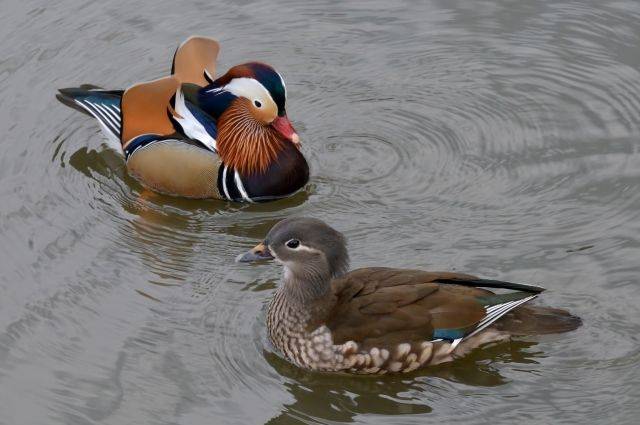

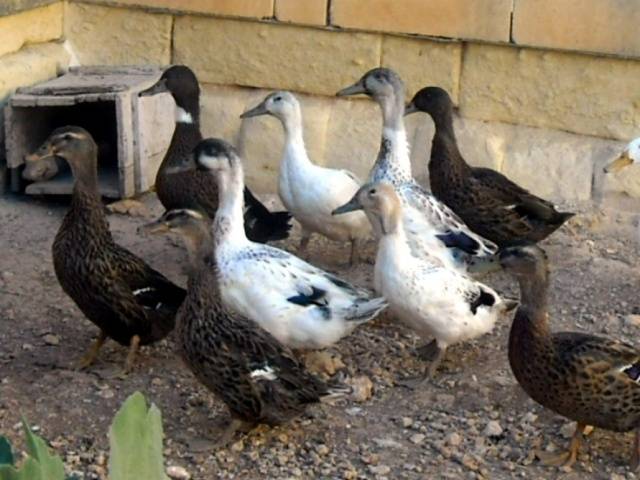

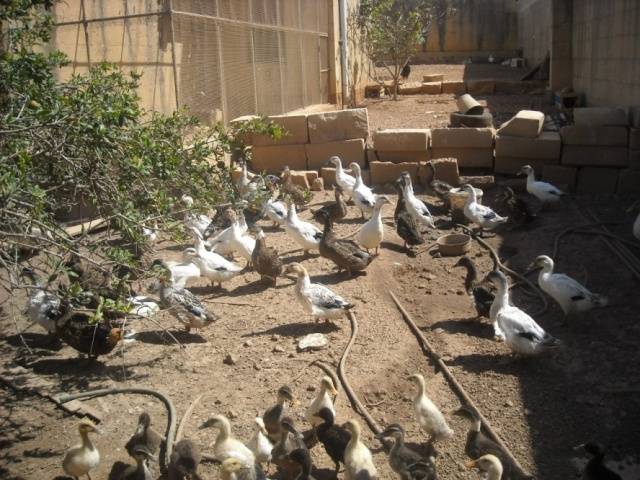
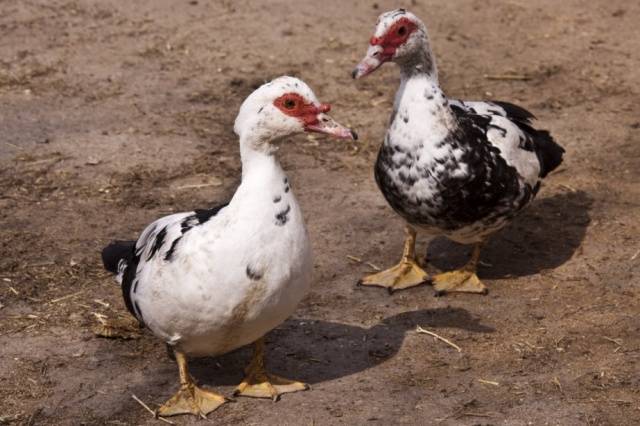
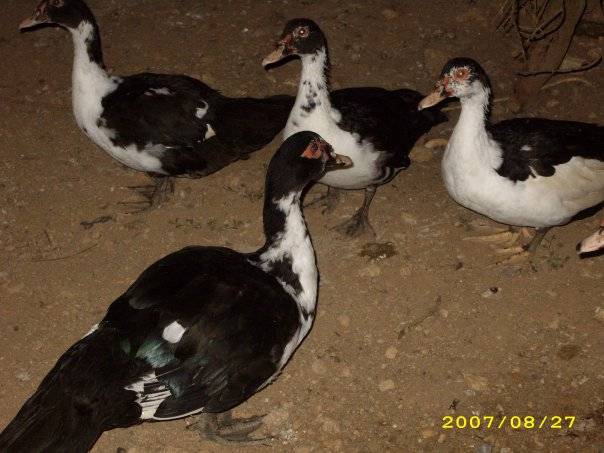
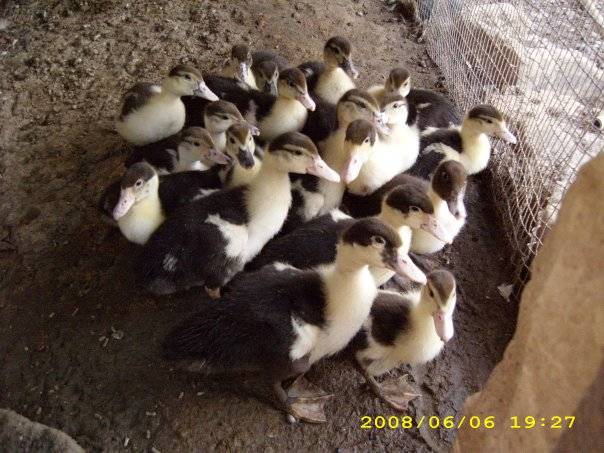
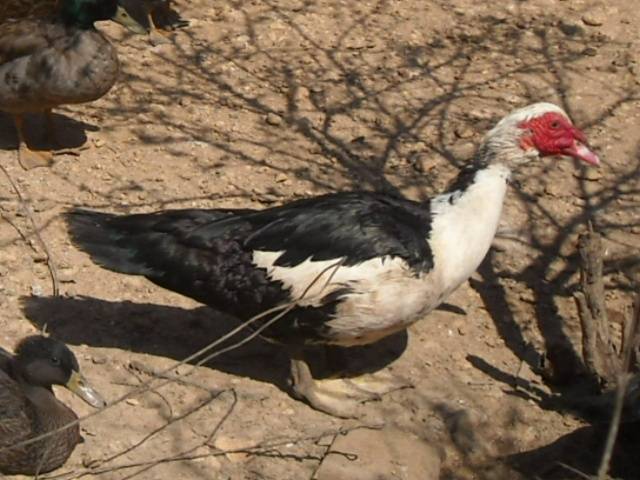

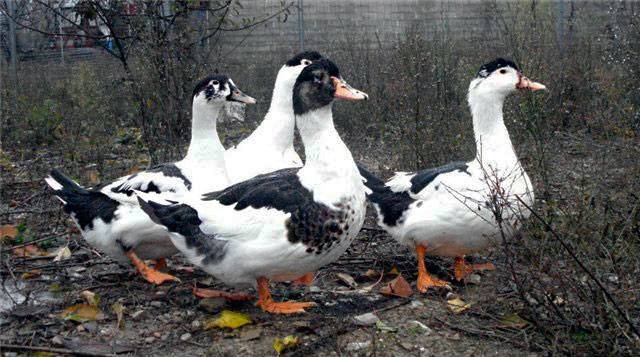
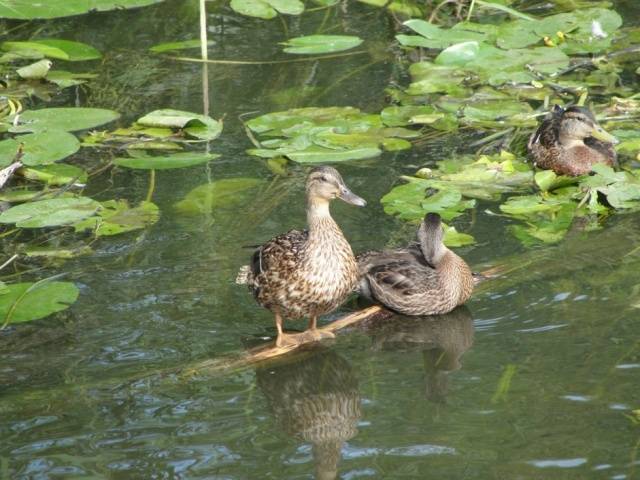
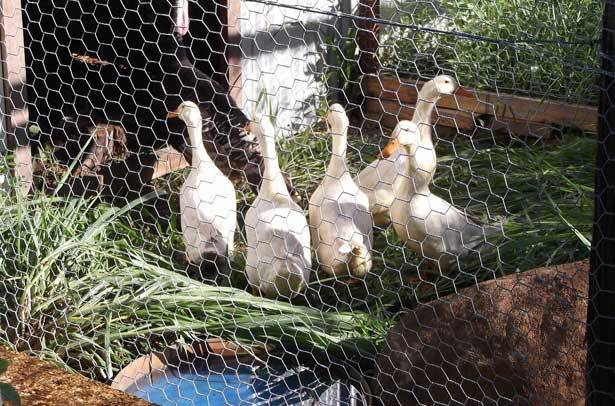



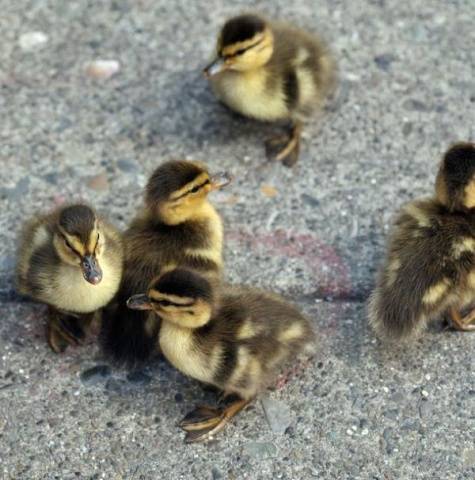
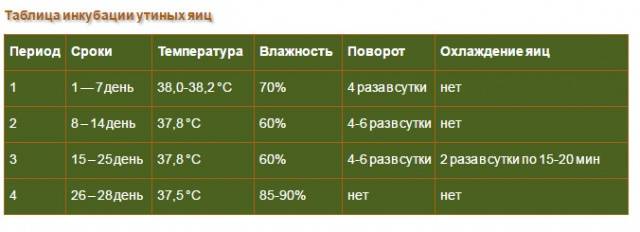
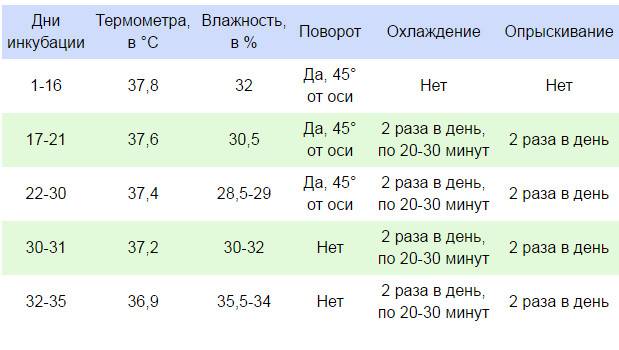
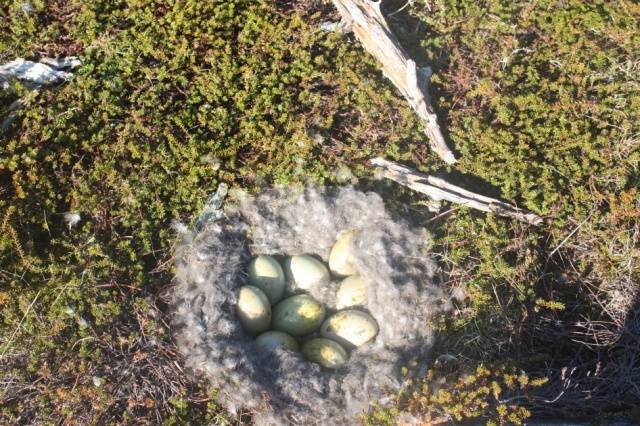

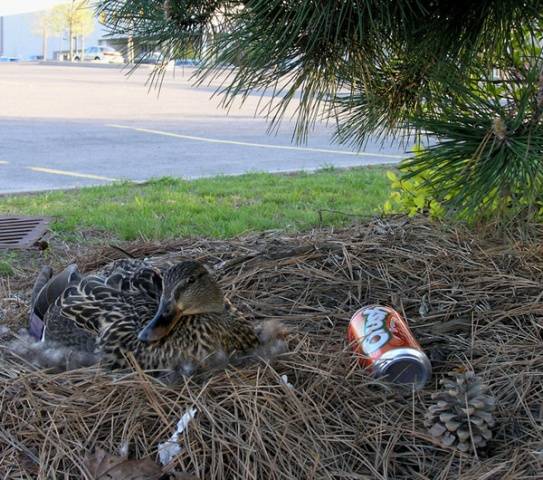
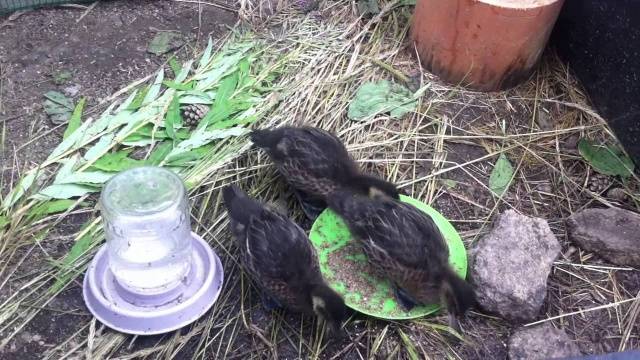










I have a problem, two ducks sat in one nest, and one sits for 15 days, and the second laid eggs on her and also sat down next to her, what about the offspring, and how they will divide the babies, and who will sit out the eggs.
Hello! Most likely, they will withdraw the first batch and consider their duty fulfilled. I would take the hatching ducklings. Then there is a chance that they will continue to incubate the later ones. And they are unlikely to share anyone. In birds, everything depends on imprinting. On whom the duckling imprinted itself, that and the mother. Even if it's a cat. So the ducklings will share it themselves.
Or the second option: the first batch will be brought out, the rest of the eggs in the incubator. I just brought out two ducklings. Either someone threw eggs at the duck, or they just lay aside for some time. But with an ovoscope I enlightened, there is a normal, somewhere two-week development of embryos. I put it in an incubator, they got out.